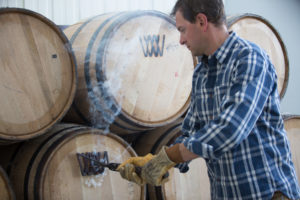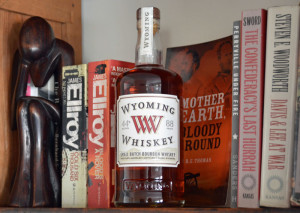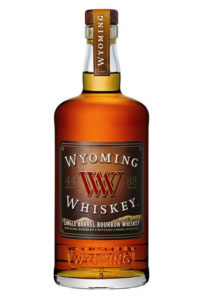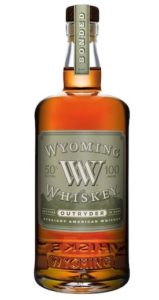A Chat With Wyoming Whiskey’s CEO
By Kurt Maitland
Earlier this year, I had the pleasure of meeting David DeFazio of Wyoming Whiskey. Wyoming is a state where having a “new” distillery is still a novelty, unlike other Western states like Utah or Colorado. “New” is in quotes because they’ve actually been at it for over a decade.
As for David, don’t know if I could describe him any better than Wyoming Whiskey’s website does: “To keep David’s bio from being too long, we’ll just make a list: lawyer, river guide, late night philosopher, angler, skier, wingman, Yankees fan, and whiskeyman”.
KM: Can you tell our readers a bit about yourself and how Wyoming Whiskey got started?
DD: The idea for Wyoming Whiskey was hatched in June of 2006 when Brad Mead and Kate Mead decided they wanted to make bourbon. They had land in the grain belt of Wyoming and it made sense to make that particular spirit given the availability of corn, wheat, and barley nearby. I had worked in their law firm for three years before starting my own firm, and Brad and I had exchanged bourbons at numerous BBQs, birthdays, and holiday events over the years. Due to the trust between us, I was asked to run the company. I am originally from the small town of Slingerlands, which is outside of Albany, New York, and moved to Wyoming before law school to be a ski bum and whitewater guide. I’d like to think that I’m still a ski bum, and I love fishing the rivers around Wyoming, but most of my time is spent building the Wyoming Whiskey brand.
KM: What was the hardest part of the early days of Wyoming Whiskey?
DD: The earliest of days weren’t that hard. We were focused on building the distillery in Kirby, sourcing water and grain, and generally dialing in production once we turned it all on. Then, we do the same thing every day and strive for consistency. We had a 33 year Maker’s Mark veteran and Bourbon Hall of Famer, Steve Nally, running the distillery so we knew we were in good hands and the foundation of our brand was solid.
The most difficult days came when we decided to release our flagship bourbon at 40 months of age. It was way too young and immature to be bottled. But, when you’ve been sampling it for three years from white dog all the way to a 40-month-old product, it tastes pretty good. So, we launched in Wyoming with a tremendous response and sold 2,400 cases in 26 seconds through the Wyoming Liquor Division.
But then the difficulty came. Most people were not impressed with our first batches of bourbon and we heard it loud and clear from consumers. So, we did a re-launch of sorts and offered to replace first-batch bottles with four year-old product and send a dozen sales people on the road to win back Wyoming. It helped. And now, after a few years, I think we’ve won back anyone that wanted to support us from the beginning by offering a five year-old bourbon and a few additional whiskies that appeal to different drinkers.
KM: When you look back at the start of the brand, what do you think helped get you where you are today?
DD: When Brad and I set out to build this company, he said that we had to do it “right”. His family has been here for four generations and has produced two governors and a United States Senator. The Hansen and Mead families built their reputation on being up front and honest. This meant no cutting corners or representing Wyoming Whiskey as something that it is not.
So, we were committed to make America’s next great bourbon by using only Wyoming ingredients from day one. All grains are grown by Brent and Sherri Rageth in Byron, Wyoming and our water comes from a mile-deep limestone aquifer in Manderson. That’s the way it will always be.
In the craft spirit market, there is a lot of deception involved in the marketing of new whiskies. We don’t want to deceive anyone. We invite anyone to come take a look and see for themselves how we do things, ask about the mistakes we’ve made, and the successes we’ve achieved and judge for themselves. There may be no “right” way to make whiskey, but we are happy with how we have gone about it.
KM: Did plan to have such a wide range of releases or did they come about via experimentation by your Master Distiller(s)?
DD: Steve was not much of an experimental guy. He believed that the only whiskey worth making was a wheated bourbon. So, when I suggested that we grow some rye and make some whiskey with rye, he nearly back-handed me. It was only after I wore Brad and Steve down that Steve acquiesced, but not without protest. He did a great job and Outryder was born. Since then, we have worked closely with Nancy Fraley to guarantee consistent quality in all of our products and we have worked together to create Double Cask, a whiskey that is matured secondarily in Pedro Ximenez casks, as well as our Single Barrel, Barrel Strength, and Private Stock selections. I enjoy the innovation and experimentation that goes into new product development, but it is not our goal to stock the shelf with as many whiskies as we can produce.
KM: What makes Wyoming a great place for you to distill?
DD: Wyoming is a remote place with many challenges that aren’t faced elsewhere. We experience tremendously hot, dry summers and brutally cold winters. This means our growing season is short and weather can make commuting to work and shipping ingredients and our final product difficult. But while the elements and obstacles create an ever present level of difficulty in Wyoming, it defines us and makes us what we are. Our whiskies are unlike any others in the world because of where and how they are made.
KM: What have you learned and what changes have been made from your earliest releases to today’s expressions?
DD: We are much better at quality control and oversight today than during our first few years. Our distiller refined what Steve built and now produces a higher quality new whiskey that forms the base of all of our products. I also think that we have earned the respect of our suppliers who now offer us options that were not available to us in the first few years. And , without question, Nancy Fraley has brought a level of sophistication to our maturation and batching protocols that has resulted in a superior product. She has abilities that are uncommon in this world and we are lucky to have her on our team.
KM: What can you tell our readers about future plans for Wyoming Whiskey?
DD: Like many small suppliers, we face the challenge of achieving effective distribution on a budget. We are intent on unlocking a route to market that will allow a far greater segment of our population to discover our whiskies. It’s not an easy task, but we think we can get there. And we have a couple of innovations that we hope will result in an additional product within a few years.
KM: Do you have a personal favorite release and if so which one and why?
DD: I like each of our products for different reasons, occasions, and moods. But if I had to reach for one product, it would be Outryder for two reasons. First, at six years of age it is a great sipping whiskey that has tremendous flavor and a wicked smooth finish. And since it has a bit of rye in it, and is bottled at 100 proof, it stands up very well in a boozy cocktail like a Manhattan.
KM: Are there whiskies you like to drink (other than your own releases) and if so have they affected what you want from your own expressions.
DD: I have always been a fan of Four Roses Small Batch and Maker’s Mark for different reasons. Each has played a role in how we approached the creation of our products.
 The Whiskey Reviewer A World of Whiskey, Poured Every Weekday
The Whiskey Reviewer A World of Whiskey, Poured Every Weekday




